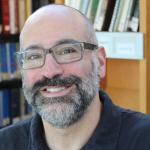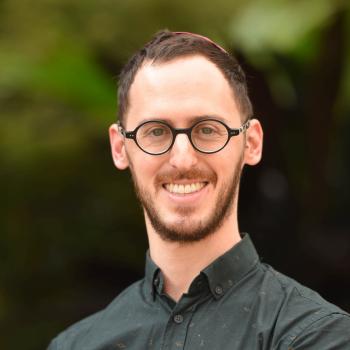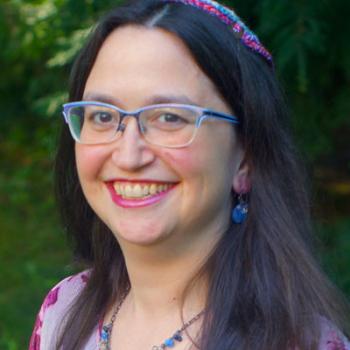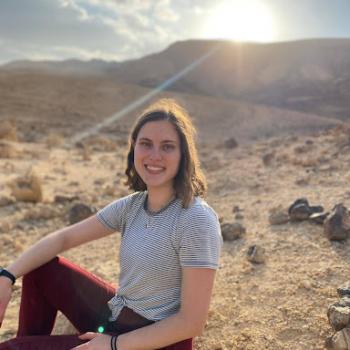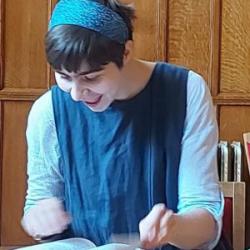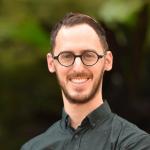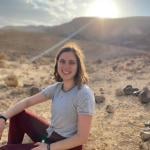By Risa Dunbar
In the summer of 2011, I spent six weeks in Israel on a program called Nesiya. Our group, composed of forty teens, half North American Jews and half Jewish Israelis, began with a three-day backpacking trek in the Negev. Two days after meeting, we were carrying 20-liter jerrycans and hoisting one another up desert craters.
Yet what I recall most about those days wasn’t physical strain, but deep encounters of awe with a vast new landscape, strangers who became trusted companions, and a mysterious new version of myself. I’m reminded of author Nicole Krauss’s reflection: “[the desert’s] crushing sense of infinite space is part of its connection to the mystical.”
This week’s Torah portion, Beha’alotkha (lit. “In your lifting up”), illuminates the physical and mystical experiences of the Israelites as they continue their second year of desert travels. Amid detail and specificity, the verses of Numbers 10:35–36 offer us a strikingly general account:
“And it was, in the journeying of the Ark, that Moshe would say: ‘Arise, O YHVH, that your enemies may scatter, that those who hate you may flee before you!’
And when it would rest, he would say: ‘Return, O YHVH, [you of] the myriad divisions of Israel!’”
Today, these words are uttered when we open the ark for the Torah service. In a Torah scroll, however, these verses are bookended by a backwards nun on either side – an unusual sight. This scribal detail has invited generations of interpretation. What do these nuns teach us about the Ark’s (and G-d’s) journeying in the desert? What insight can these nuns offer us about ourselves in our own travels through the wilderness of life?
The Kedushat Levi, the seminal work of Hasidic master Rabbi Levi Yitzchak of Berditchev (18-19c.), offers a powerful answer. He interprets this textual section as a guide for the People of Israel in how to uplift our own journeys through life. He teaches this by connecting the physicality of the backward nuns to Kabbalistic mystical concepts, cleverly employing wordplay on the root ‘uplift/elevate’ (alah – ע.ל.ה), the same root as the word for which Parshat Beha’alotkha is named.
The Kedushat Levi explains that the verses about the Holy Ark’s travels are between backwards nuns:
“Because the letter nun symbolizes the attribute of Yirah (Fear/Awe). Accordingly, one bends in deference before it, and therefore the letters [of the nuns themselves] bend [backward toward one another]. For [contrastly] anyone who is ashamed, fears facing one another [but these nuns teach us we should not be ashamed]. And [instead] this is a general principle [we have about fear]: that a person should be modest in their awe of the Divine… However, when a person wants to elevate (yaaleh) the fallen sparks [of the Shechinah’s Divinity that are scattered, and must be reunited mystically by elevating them to the Cosmic Realm], a person must publicly reveal their awe toward the Divine in order to elicit a similar desire [in others] to uplift (yaaleh) those ‘fallen’ sparks.
This idea is illustrated by our verse in Numbers 10:35–36, ‘And it was, in the journeying of the Ark, etc.’ which describes the journey of the awe-inspired Israelites through the spiritual wilderness trying to locate such “fallen” sparks and be instrumental in elevating (leha’alot) them back to their G!dly source on High. This is what the two inverted letter nuns hint at by facing one another: [their position on either side of the verses] hints at how the Israelites must reveal their awe of the Divine publicly in order to encourage any stray fallen sparks of the Shechinah to uplift (leha’alot) those pieces back to their original state of wholeness on High.”
By drawing on the Kabbalistic process of refining and returning divine sparks (נצוצות – Netzitzot) trapped in the material world to their Source, (Shechinah), the Kedushat Levi connects the physical Torah and spiritual journeys of the Holy Ark to the physical acts and spiritual world of the Children of Israel. He further articulates the significance of both the hidden and revealed parts of this process, specifying the importance of “private” character orientation and “public” displays of that character, for example. This process of “elevating sparks” (להעלות נצוצות – Leha’alot Netzizot) is also called Tikkun Olam (Repairing the World). It is essential for the ultimate redemption of the world.
The Kedushat Levi claims that we are actually the ones being addressed in this Parsha. Be’haalotkha (“in YOUR elevating”), means that by elevating our conduct during the periods of uncertainty in our lives, we have the potential to move toward sacred redemption. Each of us has the power to elevate our personal behaviors, to strive for a more awe-inspired way of relating to one another and to G?d. How can we truly embody the nuns, and act to build one another up (leha’alot) toward a more redeemed reality?
The Kedushat Levi teaches us that we must cultivate a disposition of (and actions toward) holistic awe in the desert of life. As Rabbi Abraham Joshua Heschel writes:
“Awe enables us to perceive in the world intimations of the divine, to sense in small things the beginning of infinite significance, to sense the ultimate in the common and the simple; to feel in the rush of the passing the stillness of the eternal.” (God In Search of Man)
Being in a state of awe means we sense our vast interconnection, and the power we have to transform one another.
This week, each time we say the words ויהי בנסוע הארון (“And it was, in the journeying of the Ark”) as the arks open in our synagogues, may we feel awe in the face of the vastness of all that is unknown. Even more so, may we feel this awe in the face of the person sitting beside us. May we embody the nuns in willingness to lean in with profound wonder, and to embrace the commitment to uplift one another. May we feel empowered to see our enduring journeys with life and Torah as relationships centered upon coming closer to facing one another.
Risa Dunbar (she/her) is a fifth-year rabbinical student at Hebrew College. She has served in a variety of Jewish education, ritual, justice, and leadership roles at places such as the Hebrew College Teen Beit Midrash, Camp Ramah in Northern California, Lehrhaus: A Jewish Tavern and House of Learning, BBYO, The New Israel Fund, The Southwest Orlando Jewish Center, and as the rabbinic intern and Scholar-in-Residence at Ohav Shalom in Albany, NY. This year she will serve as Rabbinic Intern to the Williams College Jewish Association and Chaplain’s Office at Williams College. Risa holds a BA from Brandeis University with a major in Anthropology, and minors in Near Eastern and Jewish Studies and Creative Writing. Her writing has been previously featured in Gashmius Magazine, and will be published as a component of the forthcoming anthology from Panui Press entitled “Returning Higher: Hasidic Inspiration for the High Holiday Journey.”


